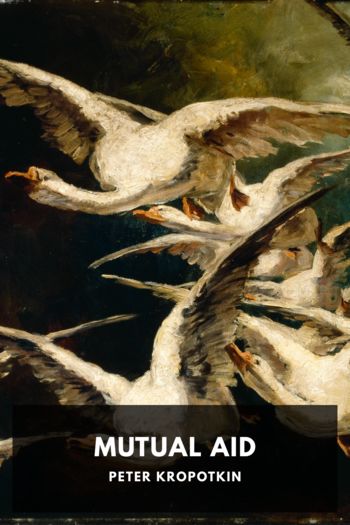The Conquest of Bread, Peter Kropotkin [the best books of all time .txt] 📗

- Author: Peter Kropotkin
Book online «The Conquest of Bread, Peter Kropotkin [the best books of all time .txt] 📗». Author Peter Kropotkin
“Shabble of a Duke” is an expression coined by Carlyle; it is a somewhat free rendering of Kropotkin’s “Monsieur le Vicomte,” but I think it expresses his meaning. —Trans. ↩
The municipal debt of Paris amounted in 1904 to 2,266,579,100 francs, and the charges for it were 121,000,000 francs. ↩
No fallacy more harmful has ever been spread than the fallacy of a “One-day Revolution,” which is propagated in superficial Socialist pamphlets speaking of the Revolution of the 18th of March at Berlin, supposed (which is absolutely wrong) to have given Prussia its representative Government. We saw well the harm made by such fallacies in Russia in 1905–1907. The truth is that up to 1871 Prussia, like Russia of the present day, had a scrap of paper which could be described as a “Constitution,” but it had no representative Government. The Ministry imposed upon the nation, up till 1870, the budget it chose to propose. ↩
The decree of the 30 March: by this decree rents due up to the terms of October, 1870, and January and April, 1871, were annulled. ↩
They have already been discovered since the above lines were written. ↩
We know this from Playfair, who mentioned it at Joule’s death. ↩
It seems that the Communists of Young Icaria had understood the importance of a free choice in their daily relations apart from work. The ideal of religious Communists has always been to have meals in common; it is by meals in common that early Christians manifested their adhesion to Christianity. Communion is still a vestige of it. Young Icarians had given up this religious tradition. They dined in a common dining room, but at small separate tables, at which they sat according to the attractions of the moment. The Communists of Anama have each their house and dine at home, while taking their provisions at will at the communal stores. ↩
Kropotkin: In Russian and French Prisons. London, 1887. ↩
A fuller development of these ideas will be found in my book, Fields, Factories, and Workshops, published by Messrs. Thomas Nelson and Sons in their popular series in 1912. ↩
A new enlarged edition of it has been published by Thomas Nelson and Sons in their “Shilling Library.” ↩
Consult La Répartition métrique des impôts, by A. Toubeau, two vols., published by Guillaumin in 1880. (We do not in the least agree with Toubeau’s conclusions, but it is a real encyclopaedia, indicating the sources which prove what can be obtained from the soil.) La Culture maraîchere, by M. Ponce, Paris, 1869. Le Potager Gressent, Paris, 1885, an excellent practical work. Physiologie et culture du blé, by Risler, Paris, 1881. Le blé, sa culture intensive et extensive, by Lecouteux, Paris, 1883. La Cité Chinoise, by Eugène Simon. Le dictionnaire d’agriculture, by Barral (Hachette, editor). The Rothamstead Experiments, by Wm. Fream, London, 1888—culture without manure, etc. (the “Field” office, editor). Fields, Factories, and Workshops, by the author. (Thomas Nelson & Sons.) ↩
Summing up the figures given on agriculture, figures proving that the inhabitants of the two departments of Seine and Seine-et-Oise can live perfectly well on their own territory by employing very little time annually to obtain food, we have:—
Departments of Seine and Seine-et-Oise Number of inhabitants in 1889 3,900,000 Area in acres 1,507,300 Average number of inhabitants per acre 2.6 Areas to be cultivated to feed the inhabitants (in acres):— Corn and Cereals 494,000 Natural and artificial meadows 494,000 Vegetables and fruit from 17,300 to 25,000 Leaving a balance for houses, roads, parks, forests 494,000 Quantity of annual work necessary to improve and cultivate the above surfaces in five-hour workdays:— Cereals (culture and crop) 15,000,000 Meadows, milk, rearing of cattle 10,000,000 Market-gardening culture, high-class fruit 33,000,000 Extras 12,000,000 Total 70,000,000If we suppose that only half of the able-bodied adults (men and women) are willing to work at agriculture, we see that 70,000,000 workdays must be divided among 1,200,000 individuals, which gives us 58 workdays of 5 hours for each of these workers. With that the population of the two departments would have all necessary bread, meat, milk, vegetables, and fruit, both for ordinary and even luxurious consumption. Today a workman spends for the necessary food of his family (generally less than what is necessary) at least one-third of his 300 workdays a year, about 1,000 hours be it, instead of 290. That is, he thus gives about 700 hours too much to fatten the idle and the would-be administrators, because he does not produce his own food, but buys it of middlemen, who in their turn buy it of peasants who exhaust themselves by working with bad tools, because, being robbed by the landowners and the State, they cannot procure better ones. ↩
ColophonThe Conquest of Bread
was published in 1892 by
Peter Kropotkin.
It was translated from French in 1913 by
Chapman and Hall.
This ebook was produced for
Standard Ebooks
by
Weijia Cheng,
and is based on a transcription produced in 2007 by
Steven desJardins, Martin Pettit, and The Online Distributed Proofreading Team
for
Project Gutenberg
and on digital scans available at the
Internet Archive.
The cover page is adapted from
Still Life with Figs and Bread,
a painting completed circa 1770 by
Luis Meléndez.
The cover and title pages feature the
League Spartan and Sorts Mill Goudy
typefaces created in 2014 and 2009 by
The League of Moveable Type.
The first edition of this ebook was released on
July 21, 2021, 12:29 a.m.
You can check for updates to this ebook, view its revision history, or download it for different ereading systems at
standardebooks.org/ebooks/peter-kropotkin/the-conquest-of-bread/chapman-and-hall.
The volunteer-driven Standard Ebooks project relies on readers like you to submit typos, corrections, and other





Comments (0)